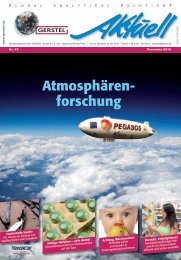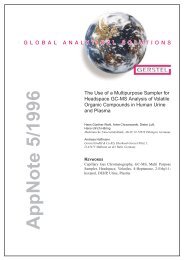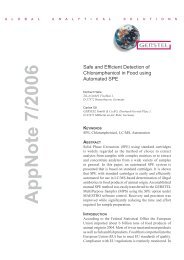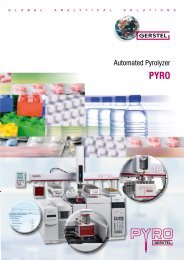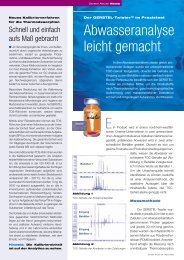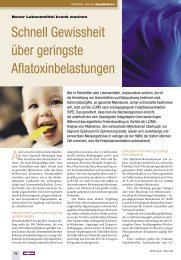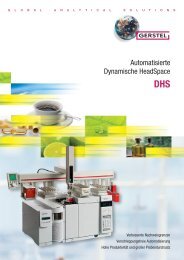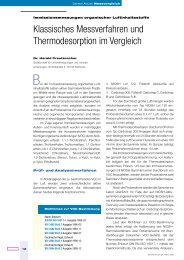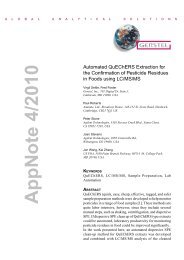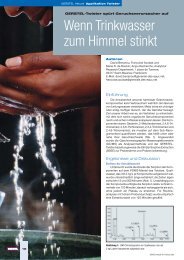2006/11 - Gerstel
2006/11 - Gerstel
2006/11 - Gerstel
You also want an ePaper? Increase the reach of your titles
YUMPU automatically turns print PDFs into web optimized ePapers that Google loves.
AppNote <strong>11</strong>/<strong>2006</strong><br />
Performance Evaluation of a Thermal<br />
Desorption System for Detection of<br />
Basic Drugs in Forensic Samples by<br />
GC/MS<br />
Joseph A. Crifasi, Michael F. Bruder, Christopher W. Long<br />
Saint Louis University Forensic Toxicology Laboratory,<br />
St. Louis, MO 63103, USA<br />
Kimberly Janssen<br />
Saint Louis University Clinical Laboratory Science Program,<br />
St. Louis, MO 63103, USA<br />
KEYWORDS<br />
SBSE, basic drugs, forensic<br />
ABSTRACT<br />
Stir bar sorptive extraction (SBSE) is an innovative sample<br />
extraction technique that can be used to process blood,<br />
urine, and tissue samples for routine drug screening in the<br />
forensic toxicology laboratory. The GERSTEL TDU System<br />
is a multifunctional thermal desorption unit capable of<br />
determining the presence of analytes from liquid samples after<br />
extraction using the Twister stir bar. The TDU desorption<br />
system was evaluated for use in combination with GC/MS for<br />
determining the presence of basic drugs in forensic samples.<br />
Human blood fortified with known quantities of drugs was<br />
used to evaluate sample diluents, extraction time, injection<br />
parameters and recovery. Case specimens containing drugs<br />
typically encountered in forensic samples were evaluated<br />
using the desorption method and compared with a liquidliquid<br />
extraction method followed by GC/MS analysis. This<br />
evaluation demonstrated that the TDU desorptive method<br />
worked equally as well as the routine extraction method for<br />
the detection of basic drugs in screening forensic samples.<br />
In addition, the described technique avoids the use of<br />
extraction solvents and the subsequent centrifugation,
transfer, and concentration steps required of liquidliquid<br />
and solid phase extraction methods.<br />
INTRODUCTION<br />
The GCMS analysis of basic drugs in biological<br />
samples is normally performed after isolation of<br />
the drug from the biological matrix. Most routine<br />
sample preparation methods are based on liquidliquid<br />
extraction, solid phase extraction, or protein<br />
precipitation. These methods require the use of organic<br />
solvents, centrifuges, rotators, and concentrators.<br />
The stir bar sorptive extraction method (SBSE)<br />
was designed to extract organic compounds from<br />
any aqueous matrix. Commercially available from<br />
GERSTEL, the Twister is a small magnetic<br />
stirring rod encased in glass and coated with a layer<br />
of Polydimethylsiloxane (PDMS). The Twister<br />
Desorption Unit (TDU) was specially designed and<br />
optimized for use with the Twister and SBSE. The use<br />
of PDMS-coated stir bars in combination with state<br />
of the art thermal desorption instrumentation and<br />
GC/MS avoids the use of solvents for extraction,<br />
reduces sample preparation time, and minimizes<br />
equipment needed for sample preparation.<br />
Previous evaluations using SBSE have included<br />
detecting specific drugs in urine, water, saliva, and<br />
bovine serum, along with analysis of pesticides in<br />
wine, contamination in lakes, and impurities and/or<br />
preservatives in food and beverage products [1-5].<br />
The purpose of this evaluation was to examine the<br />
usefulness of Twister bar extraction and thermal<br />
desorption for basic drug screening of forensic samples<br />
by GC/MS in a forensic toxicology laboratory. The<br />
intent of this contribution was also to provide a<br />
platform for future investigations involving screening<br />
and/or specific target analysis by means of Twister bar<br />
extraction.<br />
EXPERIMENTAL<br />
Instrumentation. Sample analysis was performed on<br />
two Agilent 6890 Gas Chromatographs interfaced with<br />
Agilent 5973 mass selective detectors. For the analysis<br />
of Twister samples, the 6890 GC was equipped with<br />
a PTV inlet (CIS 4) and manual Twister Desorption<br />
Unit (TDU).<br />
For the analysis of liquid-liquid extractions, the<br />
second GCMS was equipped with the Agilent split/<br />
splitless inlet and the 7673 ALS. The column used,<br />
oven temperature program, column flow, and MS<br />
conditions were the same as those described for the<br />
TDU application.<br />
Analysis conditions.<br />
Column: 35 m Rtx-5Sil (Restek)<br />
5 m Integra-guard (Restek)<br />
di = 0.20 mm df = 0.335 μm<br />
Pneumatics: He; Pi =23.6 psi;<br />
constant flow = 1.3 mL<br />
Oven: 70°C (1 min); 25°C/min;<br />
310°C (19.4 min)<br />
MSD: Scan, 40 - 550 amu<br />
Thermal desorption conditions.<br />
TDU: splitless<br />
30°C; 60°C/min; 270°C (5 min)<br />
PTV: solvent vent (50 mL/min)<br />
split 20:1<br />
-120°C; 12°C/s; 280°C (5 min)<br />
Liquid injection conditions.<br />
S/SL: 250°C, splitless<br />
Inj.-volume: 2 μl<br />
Standard Preparation. The methanolic stock standards<br />
were appropriately diluted with methanol to prepare<br />
working drug standards at a concentration of 20 mg/L.<br />
The working standards were then used to spike blood<br />
samples to the desired concentrations. The stock<br />
internal standard, SKF, was prepared at 1 mg/mL in<br />
methanol and diluted to100 mg/L for the working IS<br />
solution.<br />
Sample Preparation SBSE. Three milliliters of<br />
blood, urine, bile, vitreous, gastric contents, or tissue<br />
homogenate was pipetted into a 20 mL GC headspace<br />
vial. A 1:3 dilution was used for urine and bile. Tissue<br />
homogenates were prepared at a 1:4 dilution, and<br />
gastric contents were diluted 1:100 or 1:1000. All<br />
dilutions were made with deionized water. Exactly<br />
50μL of the 100 mg/L IS solution was added, and a<br />
10 mm stir bar (Twister, GERSTEL) coated with<br />
24 μL PDMS was added to the vial. The remaining<br />
headspace vial volume was filled with the carbonatebicarbonate<br />
buffer. The vial was sealed and the contents<br />
stirred for approximately 16 hours at room temperature.<br />
The Twister bar was then removed with a pair of<br />
forceps, rinsed with deionized water, blotted dry with<br />
a Kimwipe, and inserted into a clean TDU liner.<br />
Liquid Injection. A 3 mL aliquot of blood, urine, bile<br />
or tissue homogenate, was extracted using a standard<br />
multi-step liquid-liquid extraction method described<br />
elsewhere [6].<br />
AN/<strong>2006</strong>/<strong>11</strong> - 2
RESULTS AND DISCUSSION<br />
The purpose of this evaluation was to determine the<br />
usefulness of SBSE with the Twister bar and the<br />
Twister Desorption Unit in the routine analysis of<br />
biological samples typically analyzed in the Forensic<br />
toxicology laboratory.<br />
The Twister was desorbed using the TDU splitless<br />
mode with cryofocusing at -120ºC in the inlet. A 20:<br />
1 inlet split ratio gave excellent peak shape and good<br />
analyte responses and was therefore used for analysis<br />
of all subsequent standards and sample extracts. On a<br />
few occasions, the first blank run of the day showed<br />
trace amounts of drugs from previous injections.<br />
Repeating the blank run, or routine CIS 4 inlet<br />
maintenance (changing the liner every few weeks and<br />
solvent cleaning the inlet body as needed) eliminated<br />
carry over in the inlet.<br />
Reconditioned Twister bars were randomly<br />
desorbed and compared to new Twister bars to<br />
monitor their extraction efficiency and to check for<br />
cleanliness prior to reuse. Reconditioned Twister<br />
bars did not retain drugs from previous extractions<br />
when reconditioned as recommended.<br />
A 3 milliliter sample size was used in the Twister<br />
extraction to match the sample amount routinely used<br />
in our laboratory’s liquid-liquid basic extraction<br />
method for ease of method comparison.<br />
Several different diluents, including water, saline<br />
(pH 5.5), 30% sodium chloride (pH 8.25), and<br />
carbonate/bicarbonate buffer (pH 9.6) were evaluated<br />
for sample preparation in the Twister method. The<br />
carbonate/bicarbonate buffer gave the best overall<br />
results in terms of number of drugs detected and the<br />
area response of the target compounds used to evaluate<br />
the diluents. Extraction times of 2-hr, 4-hr and 16-hr<br />
(overnight) were evaluated and 16-hr extractions were<br />
found to give the best recovery for the largest number<br />
of drugs (data not shown).<br />
The recovery of several drugs was determined in<br />
blood which was spiked to a 0.3 mg/L concentration,<br />
extracted overnight, and desorbed with the described<br />
Twister method. The area response of the extracted<br />
drug was compared to the area response of the same<br />
amount of drug dried directly onto a Twister bar<br />
in a TDU liner. Recoveries ranged from 23%-99%.<br />
(Table 1).<br />
Table 1. Drug recovery determined for several analytes<br />
spiked at 0.3 mg/L into blood<br />
Compound<br />
Recovery<br />
[%]<br />
Compound<br />
Recovery<br />
[%]<br />
Fluoxetine 65.1 Propoxyphene 48.5<br />
Chlorpheniramine 98.9 Promethazine 88.8<br />
Sertraline 70.9 Diazepam 22.7<br />
Methamphetamine 50.7 Meperidine 78.5<br />
Diphenhydramine 86.5 Methadone 84.2<br />
Amitriptyline 84.6 Tramadol 38.0<br />
Lidocaine 59.0 Doxylamine 83.0<br />
Venlafaxine 77.0 Dextromethorphan 94.0<br />
Citalopram 82.0 Mirtazepine 77.4<br />
Chlorpromazine 70.4 Trazadone 38.7<br />
Verapamil 71.0<br />
To determine the scope of the Twister extraction<br />
method, 3mL of blood was fortified with 145 different<br />
basic drugs at 1mg/L and extracted with the described<br />
method (Table 2). The predicted Twister recovery<br />
for each drug was calculated using the GERSTEL ®<br />
TwisterCalc software. As seen in Table 2, most drugs<br />
with low predicted recoveries were not detected after<br />
Twister extraction. However, several drugs with low<br />
calculated recoveries, such as Venlafaxine, Oxycodone,<br />
Nicotine, and Methylphenidate, were detected.<br />
Some drugs with high predicted recoveries such as<br />
Mesoridazine, Nifedipine, Noscapine, Salicylic acid<br />
and Temazepam were not detected. Under the pH 9.6<br />
extraction conditions used, drugs that may contain<br />
ionized acidic groups may not be extracted.<br />
Table 2. Drugs extracted at 1 mg/L concentration in<br />
blood using Twister. Relative retention time (RRT),<br />
Twister Recovery Calculation and the Log Octanolwater<br />
partition coefficient.<br />
Compound RRT Twister Calc. log Ko/wr 2<br />
[%]<br />
Acepromazine 1.185 61.5 2.3<br />
Alprazolam 1.350 51.3 2.12<br />
Amantidine 0.547 68.8 -0.4<br />
Amitriptyline 0.968 99.8 4.94<br />
Amoxapine 1.154 nf nf<br />
Amphetamine 0.474 31.5 1.8<br />
Atropine 0.971 35.1 1.8<br />
Baclofen nd 0.1 -1<br />
Benztropine 1.012 0.4 0.4<br />
Brompheniramine 0.935 99.0 4.1<br />
Bupivicaine 0.996 95.4 3.4<br />
Bupropion 0.718 nf nf<br />
AN/<strong>2006</strong>/<strong>11</strong> - 3
Compound RRT Twister Calc.<br />
[%]<br />
log Ko/wr 2<br />
Buspirone 1.729 77.3 nf<br />
Caffeine 0.838 0.7 -0.07<br />
Captopril nd 1.7 0.34<br />
Carbamazepine 0.893 69.3 2.45<br />
Carbinoxamine 0.923 76.1 2.6<br />
Carbofuran 0.566 nf nf<br />
Carisoprodol 0.835 64.7 2.36<br />
Chlordiazepoxide 1.092 68.8 2.44<br />
Chlorpheniramine 0.897 95.0 3.38<br />
Chlorpromazine 1.09 100.0 3.4<br />
Cimetidine nd 2.0 0.4<br />
Citalopram 1.042 97.8 3.74<br />
Clomipramine 1.046 99.9 5.2<br />
Clonidine 0.931 23.7 1.59<br />
Clozapine 1.298 93.1 3.23<br />
Cocaethylene 0.988 nf nf<br />
Cocaine 0.968 61.5 2.3<br />
Codeine 1.047 <strong>11</strong>.0 0.6<br />
Colchicine nd 13.8 1.3<br />
Cotinine 0.770 nf nf<br />
Cyclizine 0.906 88.2 2.97<br />
Cyclobenzaprine 0.986 99.8 4.8<br />
Cyproheptadine 1.033 99.7 3.2<br />
Desipramine 0.988 99.8 1.4<br />
Desmethyclomimpramine 1.058 nf nf<br />
Dextromethorphan 0.986 nf nf<br />
Diazepam 1.061 84.1 2.7<br />
Diltiazem 1.340 83.1 2.79<br />
Diphenhydramine 0.837 93.7 3.3<br />
Disopyramide 1.070 75.3 2.6<br />
Doxepin 0.981 66.8 2.4<br />
Doxylamine 0.856 66.8 2.4<br />
EDDP nd nf nf<br />
Etomidate 0.852 90.0 3<br />
Flecainide 0.962 98.0 3.8<br />
Fluconazole nd 7.4 1<br />
Flunitrazepam 1.155 47.9 2.1<br />
Fluoxetine 0.830 98.9 4.05<br />
Fluvoxamine nd 0.9 0.04<br />
Guaifenesin 0.744 16.4 1.4<br />
Hydrocodone 1.073 55.9 2.2<br />
Hydromorphone nd nf -4<br />
Hydroxyamphetamine nd 13.8 1.3<br />
Hydroxyzine 1.271 66.8 2.4<br />
Ibuprofen 0.665 98.7 4.0<br />
Imipramine 0.979 99.8 2.5<br />
Ketamine 0.841 91.0 3.1<br />
Lidocaine 0.841 68.8 2.4<br />
Loxapine 1.124 97.0 3.6<br />
Compound RRT Twister Calc. log Ko/wr 2<br />
[%]<br />
Maprotaline 1.028 99.6 4.5<br />
MDA 0.663 25.9 1.64<br />
MDMA 0.689 nf nf<br />
Meclizine 1.401 100.0 5.9<br />
Meg X 0.813 nf nf<br />
Meperidine 0.790 80.8 2.7<br />
Mepivacaine 0.921 41.6 1.9<br />
Meprobamate nd 3.9 0.7<br />
Mescaline nd 4.6 0.8<br />
Mesoridazine nd 100.0 5.6<br />
Metaxalone 0.954 nf nf<br />
Methadone 0.943 98.6 3.93<br />
Methamphetamine 0.385 48.5 2.1<br />
Methaqualone 0.962 99.4 4.3<br />
Methylecgonine 0.668 nf nf<br />
Methylphenidate 0.783 1.3 0.2<br />
Metoclopramide 1.019 76.9 2.6<br />
Metoprolol 0.902 37.8 1.9<br />
Midazolam 1.125 99.4 4.3<br />
Mirtazapine 0.996 100.0 7.1<br />
6-monoacetylmorphine nd nf nf<br />
Morphine nd 5.8 -0.1<br />
Nicotine 0.599 10.6 1.2<br />
Nifedipine nd 55.9 2.2<br />
Norcitalopram 1.051 nf nf<br />
Nordiazepam 1.091 87.2 2.9<br />
Norfl uoxetine 0.822 nf nf<br />
Nordoxepin 0.987 nf nf<br />
Normeperidine 0.806 nf nf<br />
Norpropoxyphene I 1.028 nf nf<br />
Norpropoxyphene II 1.038 nf nf<br />
Norpropoxyphene III 1.043 nf nf<br />
Norpropoxyphene Amide 1.099 nf nf<br />
Nortriptyline 0.975 28.6 1.7<br />
Norvenlafaxine 0.948 nf nf<br />
Norverapamil 1.576 nf nf<br />
Noscapine nd 44.4 2.0<br />
Olanzapine 1.199 nf nf<br />
Oxycodone 1.108 3.9 0.7<br />
Papaverine 1.238 87.7 0.5<br />
Paroxetine 1.<strong>11</strong>8 98.6 3.95<br />
PCP 0.859 99.8 4.7<br />
Pentazocine 0.996 99.7 4.6<br />
Phenmetrazine 0.651 20.2 1.5<br />
Phentermine 0.493 38.9 1.9<br />
Phenylephrine nd 0.4 -0.3<br />
Phenyltoloxamine 0.917 98.1 3.8<br />
Pimozide nd 100.0 6.3<br />
PMA 0.6<strong>11</strong> nf nf<br />
AN/<strong>2006</strong>/<strong>11</strong> - 4
Compound RRT Twister Calc. log Ko/wr 2<br />
[%]<br />
PMMA 0.638 nf nf<br />
PPA nd 3.6 0.7<br />
Procainamide nd 5.7 0.9<br />
Promazine 1.036 99.6 2.5<br />
Promethazine 1.001 86.4 2.9<br />
Propofol 0.505 98.0 3.79<br />
Propoxyphene 0.846 99.2 4.2<br />
Propranolol 0.952 96.0 1.2<br />
Propylamphetamine 0.579 96.2 3.5<br />
Protriptyline 0.993 99.8 4.9<br />
Pseudoephedrine nd 5.8 0.9<br />
Quinidine 1.243 95.7 3.4<br />
Quinine 1.240 95.7 3.4<br />
Quetiapine nd 1.6 nf<br />
Ranitidine nd 1.5 0.3<br />
Salicylic Acid nd 59.3 2.3<br />
Scopolamine nd 7.1 1.2<br />
Sertraline 1.035 99.9 5.29 nd=none detected, nf=not found<br />
Compound RRT Twister Calc. log Ko/wr 2<br />
[%]<br />
SKF-525A 1.000 nf nf<br />
Strychnine 1.876 40.5 1.9<br />
Temazepam nd 55.3 2.19<br />
Theophylline nd 0.8 0<br />
Thioridazine 1.763 100.0 5.9<br />
Tiletamine 0.765 nf nf<br />
Tramadol 0.876 89.1 3.01<br />
Tranylcypromine 0.530 24.2 1.6<br />
Trazodone 1.817 92.7 3.2<br />
Trimethobenzamide 1.708 61.5 2.3<br />
Trimethoprim nd 6.1 0.91<br />
Trimipramine 0.974 100.0 5.43<br />
Venlafaxine 0.923 2.1 0.43<br />
Verapamil 1.503 98.0 3.8<br />
Zaleplon 1.372 nf nf<br />
Zolazepam 1.005 nf nf<br />
Zolpidem 1.323 98.3 3.85<br />
Postmortem blood samples from previously tested case specimens were extracted with the Twister method and<br />
compared to the described liquid-liquid extraction normally used prior to GC/MS analysis (Table 3). Twister<br />
extractions compared well with the liquid-liquid extractions followed by GC/MS analysis. The liquid-liquid<br />
extraction did not include a back extraction, and a significant cholesterol peak was noted in blood and tissue<br />
samples extracted by this method. Little, if any, cholesterol was detected in the Twister extractions (Figure 1).<br />
Abundance<br />
1.4e+07<br />
1.2e+07<br />
1e+07<br />
Blood Drug Screen<br />
Twister Extraction<br />
SKF<br />
A<br />
8000000<br />
6000000<br />
4000000<br />
2000000<br />
Propofol<br />
Diazepam<br />
Time--><br />
Abundance<br />
1.4e+07<br />
1.2e+07<br />
1e+07<br />
8000000<br />
6000000<br />
4000000<br />
Blood Drug Screen<br />
Liquid Liquid Extraction<br />
5.00 10.00<br />
15.00<br />
Propofol<br />
SKF<br />
Diazepam<br />
Cholesterol<br />
B<br />
2000000<br />
Time--><br />
5.00 10.00<br />
15.00<br />
Figure 1. Comparison of the total ion chromatograms of Twister (A) vs. Liquid-Liquid (B) Extraction of case<br />
sample. Whole blood sample was positive for Propofol at 0.5 mg/L and Diazepam at 0.08 mg/L.<br />
AN/<strong>2006</strong>/<strong>11</strong>- 5
Table 3. Comparison of Reported Case Findings and Liquid-Liquid Extraction vs. Twister Extraction followed<br />
by GC/MS Analysis.<br />
Sample Reported Results (mg/L) Liq-Liq GC/MS Results Twister GC/MS Results<br />
1 Phenobarbital (5.4) Negative Negative<br />
2 Negative<br />
(Caffeine
Sample Reported Results (mg/L) Liq-Liq GC/MS Results Twister GC/MS Results<br />
22 Chlorpheniramine (0.20)<br />
Hydrocodone (
Sample Reported Results (mg/L) Liq-Liq GC/MS Results Twister GC/MS Results<br />
41 Diphenhydramine (0.34)<br />
Methylecgonine (0.62)<br />
Cocaine (0.07)<br />
Cocaethylene (0.05)<br />
Benzoylecgonine (2.3)<br />
Morphine (0.36)<br />
42 Amitriptyline (0.61)<br />
Nortriptyline (0.59)<br />
Citalopram (0.46)<br />
Cyclobenzaprine (0.10)<br />
Temazepam (0.06)<br />
Oxycodone (0.12)<br />
43 Carisoprodal (21)<br />
Metoprolol (0.9)<br />
Hydrocodone (0.6)<br />
Acetaminophen (47)<br />
Quetiapine (
In addition to blood samples, other sample matrices such as liver, kidney, brain, bile, urine, vitreous, and gastric<br />
contents, were successfully extracted and analyzed using the Twister method (Figure 2).<br />
Abundance<br />
2e+07<br />
1.5e+07<br />
1e+07<br />
5000000<br />
Diphenhydramine<br />
Chlorpheniramine<br />
Amitriptyline<br />
SKF<br />
Nortriptyline<br />
Blood Drug Screen<br />
Diphenhydramine 0.2 mg/L<br />
Chlorpheniramine 0.48 mg/L<br />
Amitriptyline 1.4 mg/L<br />
Nortriptyline 2.1 mg/L<br />
A<br />
Time--><br />
Abundance<br />
4e+07<br />
3e+07<br />
2e+07<br />
1e+07<br />
8.00 10.00<br />
12.00 14.00 16.00<br />
Diphenhydramine<br />
Orphenadrine<br />
Venlafaxine<br />
Amitriptyline<br />
Nortriptyline<br />
SKF<br />
Urine Drug Screen<br />
Diphenhydramine <br />
8.00 10.00<br />
12.00 14.00<br />
Figure 2. Total ion chromatograms of blood (A) and urine (B) after Twister extraction. Urine diluted 1:3 with<br />
deionized water.<br />
16.00<br />
CONCLUSIONS<br />
The Twister extraction method is a viable alternative<br />
to liquid-liquid or solid phase extractions for the<br />
screening of basic drugs in biological samples. This<br />
method:<br />
- Simplifies the extraction compared to typical<br />
multi-step sample preparation.<br />
- Eliminates the need for the equipment and the<br />
solvents usually needed for extractions.<br />
- Twister stir bars are reusable and do not appear<br />
to carry over analytes from previous extractions<br />
once desorbed and reconditioned.<br />
The use of the Twister method for forensic samples<br />
would require that each Twister bar be tested after<br />
reconditioning to document that it is negative for the<br />
analytes being tested.<br />
REFERENCES<br />
[1] Sandra, P., Baltusssen, E., David, F., Hoffmann,<br />
A., <strong>Gerstel</strong> Application Note, 1/2000.<br />
[2] Vendenin, A., Suvorkin, V., and Kachur, E.,<br />
<strong>Gerstel</strong> Application Note, 7/2004.<br />
[3] Strano-Rossi, S., Molaioni, F., and Botrè, F., J.<br />
Anal. Tox. Volume 29, May/June 2005, p 217-<br />
222.<br />
[4] Kinton, V., Whitecavage, J., <strong>Gerstel</strong> Application<br />
GUS-195-EP.<br />
[5] Pfannkoch, E., Whitecavage, J., Bramlett, R.,<br />
<strong>Gerstel</strong> Application Note, 6/2005.<br />
[6] Crifasi, J., Bruder, M., Long, C., and Janssen, K.<br />
J. Anal. Tox. Volume 30, October <strong>2006</strong>, p 1-12.<br />
“For research use only. Not for use in diagnostic procedures.”<br />
The information provided for this product is intended for reference<br />
and research purposes only. GERSTEL offers no guarantee as<br />
to the quality and suitability of this data for your specific<br />
application.<br />
Information, descriptions and specifications in this publication<br />
are subject to change without notice.<br />
AN/<strong>2006</strong>/<strong>11</strong> - 9
GERSTEL GmbH & Co. KG<br />
Eberhard-<strong>Gerstel</strong>-Platz 1<br />
D-45473 Mülheim an der Ruhr<br />
Germany<br />
+49 (0) 208 - 7 65 03-0<br />
+49 (0) 208 - 7 65 03 33<br />
gerstel@gerstel.com<br />
www.gerstel.com<br />
GERSTEL Worldwide<br />
GERSTEL, Inc.<br />
701 Digital Drive, Suite J<br />
Linthicum, MD 21090<br />
USA<br />
+1 (410) 247 5885<br />
+1 (410) 247 5887<br />
sales@gerstelus.com<br />
www.gerstelus.com<br />
GERSTEL AG<br />
Wassergrabe 27<br />
CH-6210 Sursee<br />
Switzerland<br />
+41 (41) 9 21 97 23<br />
+41 (41) 9 21 97 25<br />
gerstel@ch.gerstel.com<br />
www.gerstel.ch<br />
GERSTEL K.K.<br />
1-3-1 Nakane, Meguro-ku<br />
Tokyo 152-0031<br />
SMBC Toritsudai Ekimae Bldg 4F<br />
Japan<br />
+81 3 5731 5321<br />
+81 3 5731 5322<br />
info@gerstel.co.jp<br />
www.gerstel.co.jp<br />
GERSTEL LLP<br />
Level 25, North Tower<br />
One Raffles Quay<br />
Singapore 048583<br />
+65 6622 5486<br />
+65 6622 5999<br />
SEA@gerstel.com<br />
www.gerstel.com<br />
GERSTEL Brasil<br />
Av. Pascoal da Rocha Falcão, 367<br />
04785-000 São Paulo - SP Brasil<br />
+55 (<strong>11</strong>)5665-8931<br />
+55 (<strong>11</strong>)5666-9084<br />
gerstel-brasil@gerstel.com<br />
www.gerstel.com.br<br />
Information, descriptions and specifications in this<br />
Publication are subject to change without notice.<br />
GERSTEL, GRAPHPACK and TWISTER are registered<br />
trademarks of GERSTEL GmbH & Co. KG.<br />
© Copyright by GERSTEL GmbH & Co. KG<br />
Awarded for the<br />
active pursuit of<br />
environmental sustainability



